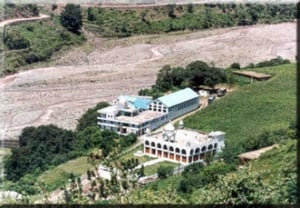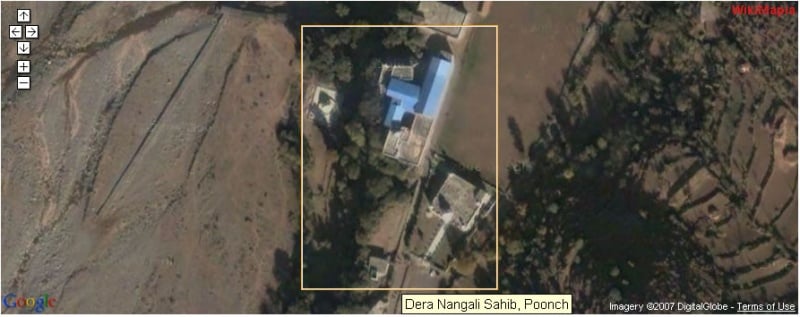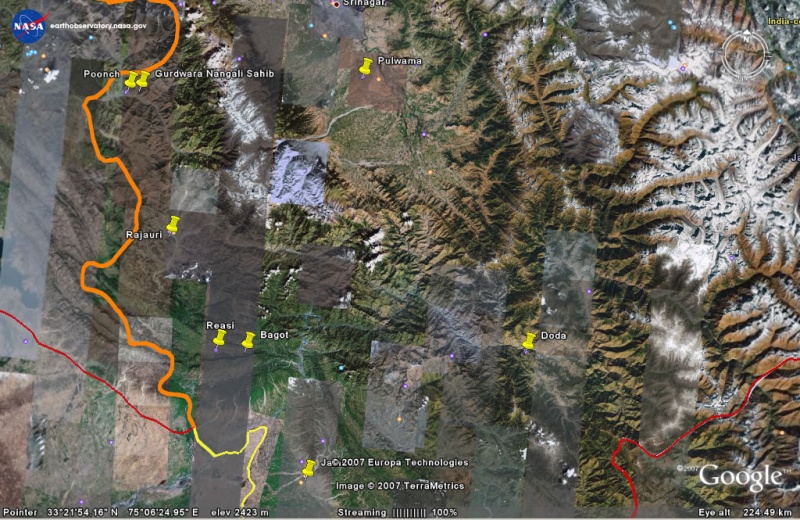Gurdwara Nangali Sahib (Poonch): Difference between revisions
Allenwalla (talk | contribs) m (MBS College of Engineering and Technology, Jammu! is Mukhi-Sewdar (face - ___) translation? a mahant term?) |
Allenwalla (talk | contribs) m (could someone translate - Mukhi-Sewdar, is this a Mahant term see discussion. thanks) |
||
| Line 3: | Line 3: | ||
Everest Mountaineering Club, Rajouri</small></center>]] | Everest Mountaineering Club, Rajouri</small></center>]] | ||
'''Gurudwara Nangali Sahib''' is situated in the lap of a picturesque hill and on the bank of Drungali Nallah. It is about 4 kms from {{wiki|Poonch}} town in {{wiki|Poonch district}}, which is the smallest of the 14 districts of [[Jammu & Kashmir]] State. It is one of the oldest shrines of the [[Sikhs]] in [[India|Northern India]]. Presently the | '''Gurudwara Nangali Sahib''' is situated in the lap of a picturesque hill and on the bank of Drungali Nallah. It is about 4 kms from {{wiki|Poonch}} town in {{wiki|Poonch district}}, which is the smallest of the 14 districts of [[Jammu & Kashmir]] State. It is one of the oldest shrines of the [[Sikhs]] in [[India|Northern India]]. Presently the Gurudwara complex consists of the main Gurdwara building, a Guru ka Langar [[free community kitchen]] and about 70 guest rooms. Large numbers of devotees from varying faiths visit this shrine from all over the country and world yearly. | ||
This holy [[Sikh shrine]] is approximately 240km. from {{Wiki|Jammu}} city by road (but only about 150km {{wiki|as the crow flies}}) which in turn is connected to rest of the world via road, rail and airline network. Pilgrims outside the state may use railways or air services up to {{wiki|Jammu}} and then travel by road to {{wiki|Poonch}}. | This holy [[Sikh shrine]] is approximately 240km. from {{Wiki|Jammu}} city by road (but only about 150km {{wiki|as the crow flies}}) which in turn is connected to rest of the world via road, rail and airline network. Pilgrims outside the state may use railways or air services up to {{wiki|Jammu}} and then travel by road to {{wiki|Poonch}}. | ||
The | The Gurdwara was established by Thakur [[Bhai Mela Singh]] ji (the fourth successor of [[Sant Bhai Feru Singh]] ji) in 1803. [[Maharaja Ranjit Singh]] visited Gurudwara Nangali Sahib in 1814. Greatly impressed with the Gurdwara he attached a jagir (an estate to provide income) to the Gurudwara sahib. Twenty years later the Maharaja later attached a four village jagir to the Gurudwara sahib's holdings in the year 1823. | ||
In 1947, the original building was | In 1947, the original building was burned out during the attacks of the [[Pakistan]] supported mountain tribals, but with the donations and sewa (service) of the local [[Sangat]] (people having faith in the Almighty) the Gurudwara was reconstructed under the supervision of Mahant Bachitar Singh ji. This Gurudwara has remained as a focus of [[Sikhism]] in the state of [[Jammu and Kashmir]]. An around the clock Langar and serai (rest house facility) is provided to pilgrims regardless of their religion, caste or creed. Although people visit this shrine daily, on Sundays a large congregation ([[Diwan]]) is held. | ||
The cool mountain air, which has always attracted people to the area; the vistas of breath taking scenery and the moving spiritual ambiance of this remarkable Gurdwara in this remarkable place | The cool mountain air, which has always attracted people to the area; the vistas of breath taking scenery and the moving spiritual ambiance of this remarkable Gurdwara in this remarkable place makes for a memorable experience for any pilgrim or visitor as they leave with a feeling of great peace and solace of mind. | ||
==Special Events== | ==Special Events== | ||
Revision as of 11:27, 15 March 2008
Gurudwara Nangali Sahib is situated in the lap of a picturesque hill and on the bank of Drungali Nallah. It is about 4 kms from Poonch town in Poonch district, which is the smallest of the 14 districts of Jammu & Kashmir State. It is one of the oldest shrines of the Sikhs in Northern India. Presently the Gurudwara complex consists of the main Gurdwara building, a Guru ka Langar free community kitchen and about 70 guest rooms. Large numbers of devotees from varying faiths visit this shrine from all over the country and world yearly.
This holy Sikh shrine is approximately 240km. from Jammu city by road (but only about 150km as the crow flies) which in turn is connected to rest of the world via road, rail and airline network. Pilgrims outside the state may use railways or air services up to Jammu and then travel by road to Poonch.
The Gurdwara was established by Thakur Bhai Mela Singh ji (the fourth successor of Sant Bhai Feru Singh ji) in 1803. Maharaja Ranjit Singh visited Gurudwara Nangali Sahib in 1814. Greatly impressed with the Gurdwara he attached a jagir (an estate to provide income) to the Gurudwara sahib. Twenty years later the Maharaja later attached a four village jagir to the Gurudwara sahib's holdings in the year 1823.
In 1947, the original building was burned out during the attacks of the Pakistan supported mountain tribals, but with the donations and sewa (service) of the local Sangat (people having faith in the Almighty) the Gurudwara was reconstructed under the supervision of Mahant Bachitar Singh ji. This Gurudwara has remained as a focus of Sikhism in the state of Jammu and Kashmir. An around the clock Langar and serai (rest house facility) is provided to pilgrims regardless of their religion, caste or creed. Although people visit this shrine daily, on Sundays a large congregation (Diwan) is held.
The cool mountain air, which has always attracted people to the area; the vistas of breath taking scenery and the moving spiritual ambiance of this remarkable Gurdwara in this remarkable place makes for a memorable experience for any pilgrim or visitor as they leave with a feeling of great peace and solace of mind.
Special Events
In addition to observance of daily ceremonies, a special diwan (congregation) is held on every weekend (Sunday). The congregation is attended by a large number of people of Poonch.
A gigantic function is held in the Gurudwara Sahib on the eve of Baisakhi every year. A large number of devotees from Jammu and Kashmir in particular and from around the world in general participate in the day-long function of Baisakhi - the Birth (establishment) day of Khalsa.
Additional Information
Shromani Dera Nangali Sahib Poonch: This Sikh institution was started by Bhai Mela Singh Ji (4th Mahant). Guru Gobind Singh ji presented a Khanda (a double edged sword) and a Bata (bowl) to Bhai Pheru Singh (1st Mahant) and sent him to share Sikhism with the people of Jammu and Kashmir. Bhai Pheru was present on the occasion when Guru Gobind Singh created the Khalsa and was part of that august group which first were called Singhs (Lions). Since then the Gurdwara has been sharing Guru Nanak's message of peace and brotherhood —Sikhi in the hills of Jammu & Kashmir as per the wishes of Guru Sahib ever since.
Currently Mukhi-Sewdar: Bhai Manjit Singh ji, who is 13th in the row, is doing the Seva at this important shrine. Presently the Dera is running several Sikh schools, colleges and professional institutions prominent among those are:
- MBS College of Engineering and Technology, Jammu
- and Guru Harkishen Public School, Jammu.
People across the state from all walks of life visit here the whole year. This Gurdwara is revered as 'Shiromini Dera' (the holy place). Sikhi is preached here as per Gurbani.
List of dedicated Sevadars of Gurdwara Nangali Sahib, Poonch
|
|
External Links
- Above information provided by user:sarbjeet_1313me



